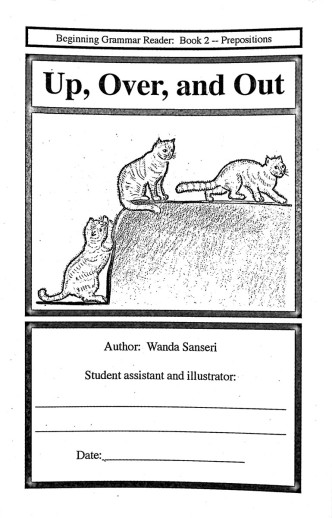We use cookies to make your experience better. To comply with the new e-Privacy directive, we need to ask for your consent to set the cookies. Learn more.
Up, Over, and Out Beginning Grammar Reader (Spell to Write & Read)
All the selections in Up, Over, and Out deal with pets or would-be pets. Several are animals observed in the wild. Wanda field-tested the grammar readers with students of various ages. The children were all delighted with them.
Some grammar books consider preposition to be a difficult concept to teach, but these books helped children who did not know how to identify a preposition to do so with ease.
One of the teachers who taught Wanda years ago successfully did this abbreviated form of diagramming with her first grade classes. Wanda was amazed by the idea of teaching at such a young age something that she had found helpful in high school. She tried it with young children with the same success. Wanda knows of nothing else on the market quite like these booklets. A side benefit is that the beginning grammar readers also gently teach grammar to the teacher who feels insecure in this area.
One happy educator wrote, "I just finished Kindergarten with my 5-year old son who is "all boy"! He is constantly "working" on something around here...mostly building forts and digging for dinosaur bones, so it takes a lot to get his mind off of those other things. At the end of the year, I stumbled upon your Grammar Readers. Wow! He absolutely loves these, and begs to do more than one page at a time!! They have been an enormous help to me." Another reports, "My daughter loves drawing the pictures."
Programs in this section go beyond teaching children how to read, incorporating phonetic readers, spelling and writing as well. Arranged roughly by grade/age.
What do The Writing Road to Reading, and this program, Spell to Write & Read have in common? Both have similar (and potentially confusing) names. Both would be labeled intensive phonics. And Both would claim a teaching progression something like this: sounds of speech - building words - developing a spelling vocabulary - writing original sentences - and then reading follows. If that sounds a little backwards to you, remember that these programs have very devoted followers who claim great success using this methodology and Spell to Write and Read is one of Cathy Duffy's 100 Top Picks for Homeschooling Curriculum.
Spell to Write and Read by Wanda Sanseri is an updated replacement for a previous program (Teaching Reading at Home and School) and is designed exclusively to work with the W.I.S.E. Guide for Spelling, also by Mrs. Sanseri. While SWR and the WISE Guide are considered a reading and spelling program, they could also be used as a stand-alone spelling program for a child who is already reading. SWR functions as a step-by-step teacher's guide to accompany the specific word lists in the WISE Guide. Covering preparation, philosophy, preschool pointers, reading aloud, evaluating achievement levels, and teaching penmanship with phonograms, it also illustrates in scripted detail the spelling dictation process and the spelling rule Reference Pages with instructions and examples. These spelling rule Reference Pages are central to the entire teaching/learning system. Ideas for reading assignments, ways to improve comprehension skills and refine composition skills round out the teacher's tools. In summary, this is the overall master book of a product combination that works together to teach the first four to five years of language arts or to remediate students of any age. The other components include the WISE Guide, 70 Basic Phonogram Cards, Spelling Rule Cards, 70 Basic Phonograms CD, the Primary Learning Log, and the Black Learning Log (more details on these below).
The W.I.S.E. Guide for Spelling (W.I.S.E. stands for Words, Instruction, and Spelling Enrichments) includes a core spelling list that is an updated version of the well-known Ayres List - a foundational vocabulary of 2000 spelling words. Words are divided into manageable daily lessons with 2 pages of teaching ideas for each set of 20 words. Each lesson has preliminary warm-up drills, motivational comments for introducing the lesson, and reminders to teach specific Reference Pages from SWR. Sample sentences are given to illustrate each word. Selections come from the Bible, literature, quotes from famous people, or instructive comments. Each word is divided into syllables and marked for spelling rules. Suggested teacher dialogue is provided. Optional enrichment activities involve a wide variety of subjects - art, literature, composition, grammar, etymology, alphabetizing, analogies, oxymorons, and many more.
This program, like other intensive phonics programs, is exceedingly detailed and painstakingly comprehensive and thorough. The extreme attention to detail would detract for many, but for those who want to follow a thoroughly researched and carefully implemented approach, this may be for you. ~ Janice
| Product Format: | Paperback |
|---|---|
| Brand: | Spell to Write and Read |
| Grades: | 1-2 |
| ISBN: | 9781880045428 |

